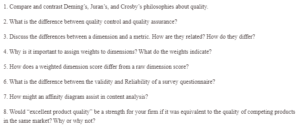Deming, Juran, and Crosby Philosophies About Quality
Explain the difference between internal and external customers.
External customers are people outside of an organization who receive goods or
Internal customers are people inside an organization that receives goods or services. (Sower, 2001, pg. 6)
What might be some dangers of relying solely on customer input when designing or improving a product or service? What other inputs should be taken into account?
One danger of relying solely on user-based input when designing or improving a product or service is its limited value. Products based on customer input may be radical, thus producing a good or service for a market that doesn’t. Most customers cannot truly articulate that need, resulting in creations based on interest rather than necessity. Other inputs that could be considered are the transcendent, product-based, manufacturing, and value-based approaches.
Compare and contrast Deming’s, Juran’s, and Crosby’s philosophies about quality.
Deming philosophy was based on improving the products and services by reducing uncertainty and variability in the design and manufacturing processes. Variation is considered the only reason for people with low incomes. He advocated improving the system rather than the workers. ((Sower, 2001, pg. 12)
Juran viewpoint was based on a firm’s existing strategic planning and minimum risk in
According to www.ukessays.com, his quality management method focuses on the interdependencies of manufacturing functions, process control, testing, and feedback, and the quality system needs to be continuous and never-ending. The three quality aspects are called the quality trilogy: quality planning, quality control, and quality improvement.
-Crosby’s philosophy on quality management is based upon the absolutes of quality management, which means the performance standard is zero defects.
What is the difference between quality control and quality assurance?
Quality assurance focuses on the entire quality system, from suppliers to the consumers of the product or services. Quality control has a narrow focus. It focuses on the quality of the production process and how to eliminate
Discuss the differences between a dimension and a metric. How are they related? How do they differ?
A metric is a standard of quantitative measurements, and Dimensions are characteristics of your data. For instance, referencing a particular location can indicate a dimension. The numeric representation of a city’s population can be considered a metric. To use dimensions to measure the quality of a particular good or service, the dimension’s characteristics must be measurable (metrics).
Why is it important to assign weights to dimensions? What do the weights indicate?
You cannot directly measure dimensions simply from its Each characteristic has to be assigned a weight, a metric of some sort. Weights can indicate the relative importance of each dimensional characteristic. For instance, quality may weigh twice as much as features or equal to performance. Without weights, all characteristics will be assumed to be equally important, rendering a product or service unobtainable.
How does a weighted dimension score differ from a raw dimension score?
Raw dimensions are counts of observed events, but not yet Weighted dimensions are measured.
What is the difference between the validity and Reliability of a survey questionnaire?
Validity is the degree to which the instrument measures what it purports to. Reliability refers to the instrument’s ability to provide consistent results. (Sower, 2001, pg. 42)
How might an affinity diagram assist in content analysis?
Affinity diagrams assist in content analysis by helping organize ideas and facts relating to broad concepts and Utilizing affinity diagrams to simplify large quantities of information.
Would “excellent product quality” be a strength for your firm if it was equivalent to the quality of competing products in the same market? Why or why not?
Excellent product quality, as a strength in a market where quality is comparable, is not a huge strength. If competitors can match a firm’s product or service’s quality, it becomes an industry standard rather than an advantageous attribute. Acknowledging a characteristic is a firm’s strength implies that there is a weakness on behalf of its
References
Compare and Contrast the different quality philosophies, systems, and approaches. (n.d.). Retrieved July 09, 2016, from https://www.ukessays.com/essays/management/compare-and-contrast-the-different-quality-philosophy-systems-and-approaches-management-essay.php
Sower, V. 2001. Essentials of Quality: with cases and experiential exercises. Hoboken, New Jersey: John Wiley & Sons, Inc.
ORDER A PLAGIARISM-FREE PAPER HERE
We’ll write everything from scratch
Question
1. Compare and contrast Deming’s, Juran’s, and Crosby’s philosophies about quality.

Deming, Juran, and Crosby Philosophies About Quality
2. What is the difference between quality control and quality assurance?
3. Discuss the differences between a dimension and a metric. How are they related? How do they differ?
4. Why is it important to assign weights to dimensions? What do the weights indicate?
5. How does a weighted dimension score differ from a raw dimension score?
6. What is the difference between the validity and Reliability of a survey questionnaire?
7. How might an affinity diagram assist in content analysis?
8. Would “excellent product quality” be a strength for your firm if it was equivalent to the quality of competing products in the same market? Why or why not?

